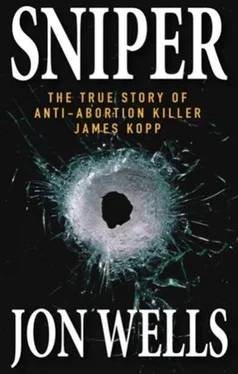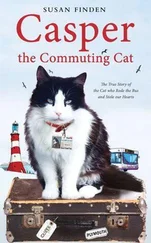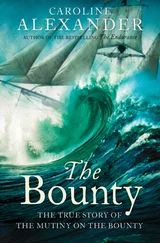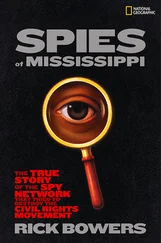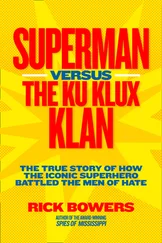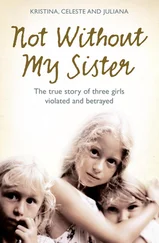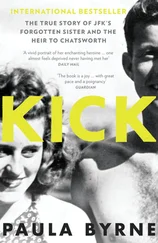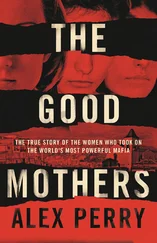Jon Wells
SNIPER
The True Story of Anti-Abortion Killer James Kopp
To Dana Robbins,
with gratitude for his encouragement, guidance and friendship
I want to thank Dana Robbins and Roger Gillespie for their support and suggestions when I worked on the original “Sniper” story for the Hamilton Spectator; also lead editor Dan Kislenko, and Douglas Haggo. Special thanks to Scott Gardner who photographed the story and was an indispensable colleague and friend on the road. I thank Kirk LaPointe for giving me my first big career break and my first crack at long-form journalism.
I appreciate the support of the book undertaking from current Spectator editor-in-chief David Estok, publisher Ian Oliver, and especially managing editor Jim Poling, who stickhandled the contract. Thanks to Carmelina Prete, Pete Reintjes, and Scott Petepiece for suggestions and feedback. And of course I thank the people at John Wiley & Sons.
Most of all, I note the contributions of those who provided information that helped me craft the story. Chief among these were the Hamilton detectives who investigated the sniper attack on Dr. Hugh Short and who are referenced in the piece. The case, like all of the attacks, is a disturbing one. I thank them for their participation and candor. I also want to single out assistance from FBI profiler James Fitzgerald at the Behavioral Analysis Unit in Quantico, Virginia, and special agents Bernie Tolbert and Michael Osborn. Finally, I take advantage of this opportunity to thank my family for their love and inspiration. You mean everything.
Jon Wells Hamilton, Ontario
Dark, early evening in Dublin. Wet cobblestone glistens under streetlights, a damp, bracing nip in the air. The writer checked his watch. Six o’clock. It had been 72 hours since he met the sniper for the first time, back in the United States. James Charles Kopp. “What was… the weather like, this morning, where you live?” was the first thing Kopp had said, quietly, deliberately, as though expecting some kind of code phrase in reply. And now, across the Atlantic, the writer ducked into a crowded Dublin cybercafe and checked email. Finally, the message was in. Subject: From Jim.
That was how I led the opening chapter of an early draft of Sniper. I showed it to my editor Roger Gillespie and he asked why was I inserting myself into the story? I got the message, and Roger was correct, as usual. The true story of anti-abortion doctor killer James Kopp ran every day in the Hamilton Spectator over the course of seven weeks in 2004. I have now polished, updated and edited the narrative for this book. Looking back, my writer-in-Dublin theme no doubt reflected my fascination as I chased Kopp’s shadow far and wide. Research over a tenmonth period took me from crime scenes in Hamilton, Ontario, Winnipeg, Vancouver, and Amherst, New York, to New York City, San Francisco, Ireland and France.
Sniper’s length and narrative voice were, and remain, unusual in the world of print journalism, but it was not my first project of that nature—that was Poison, a series which won a National Newspaper Award in Canada. I note that while Poison, Sniper, and my other serials to date are written in a novelistic style, all of the detail, dialogue, and thoughts of the characters are true, based entirely on reportage.
In order to craft the story of James Kopp’s life and crimes I interviewed nearly 100 people, ranging from those he went to high school with, to prosecutors and defense lawyers at home and abroad, more than a dozen law enforcement officers ranging from FBI agents to city detectives, and individuals on the radical fringe of the anti-abortion movement. I studied hundreds of pages of court transcripts and FBI search warrant documents—and loaded and fired an SKS assault rifle at a shooting range. In large measure what made Sniper such a compelling and at times disturbing creative journey for me was the access I gained to James Charles Kopp. To my knowledge, while the paranoid Kopp has been sought by print and TV journalists in Canada and the United States over the years, he has never engaged in any in-depth contact with any of them. As it happened, I was able to exchange many letters with him and meet for several hours of face-to-face interviews. This access allowed me to better retrace his early life in the San Francisco area, and his steps while on the lam from police and the FBI overseas. It also provided opportunity to get inside his head, understand the way he talked and thought. Immersing myself in his world was at times difficult to take, but it did help me write Sniper with more authority and color than otherwise would have been possible. I have told this story using different voices—Kopp’s most notably, but also those of law enforcement and anti-abortion activists all along the spectrum. A note to the reader: I don’t always telegraph when the voice changes, and the language used when visiting the fringe of the anti-abortion/pro-life movement is often quite graphic.
I have told colleagues the story of my unprecedented experience interviewing Kopp in person. He agreed to talk but also refused to let me record him or even take notes. It was no doubt his way of trying to provide deniability for whatever I would write. (I can hear him now: “Jon Wells? Never heard of him. Knew a Wells in the Bay Area once but that’s another story…”) When I left each of our interview sessions I immediately turned on my tape recorder and dictated. While Kopp rambled on many tangents, much of what he said stuck with me—indeed, probably for longer than I would have liked. Eventually Kopp stopped contacting me altogether, just as he told me he would one day without warning, and just as he vowed to others he knew over the years. As the story illustrates, this was at his core. Unpredictability, deception—what he called “Romanita”—even towards his friends and family, was by his reckoning essential for everyone’s own good, and the good of a movement for which he ultimately deemed it a moral necessity to shoot doctors under cover of darkness.
The letters he did mail my way were unusual to say the least, peppered with code phrases and references that were difficult to decipher. He listed names of friends for me to try and visit. I was, he assured me, all along being “vetted” by allies of his. There were times when Kopp’s friends were less than anxious to admit their affiliation with him, however. I found a priest at a hermitage high atop breathtaking Big Sur who would have nothing to do with me when I told him the story I was writing, and an elderly woman named Beatrice in San Francisco shut the door in my face when I mentioned Jim Kopp’s name. As for the emails he forwarded through a third party when I was in Ireland and France, some of the tips were so cryptic I never did figure them out while others panned out quite nicely—like the one I quoted in that early draft, when a writer hungrily retrieved a message in Dublin containing advice on where to go and who to meet, all while warning of traps lying in wait.
Subject: From Jim
Be careful. Interpol could retrace your steps… Please do not ask first or last names. Do not ask or write down first names. Do not attribute. These are my close friends. They saved my life. They know nothing. I am Timothy.
As this book relates, the sniper himself did not sufficiently heed his own warnings.
Chapter 1 ~ A Burning Cross
Amherst, N.Y.
October 23, 1998
9:55 p.m.
A gray-blue eye boring through the rifle scope into the window of the doctor’s home 100 feet away, meeting a turquoise electric glow in the white kitchen. Must be the microwave, he thought. The target standing, raising his left arm, the mass of the shoulder in the crosshairs—and disappearing. The sniper waiting, bracing himself against a tree in the woods. The doctor—the abortionist—must have pressed the numbers on the microwave, he thought, and left the room. The sniper calculated that the abortionist would return, to that very spot, in 35, maybe 40 seconds. You can cut a few holes in the fences around the death camps. Derail some trains. Let a few babies crawl to freedom. A mere trickle of relief in the abortion Holocaust. But you do it. It is your duty to do it.
Читать дальше
